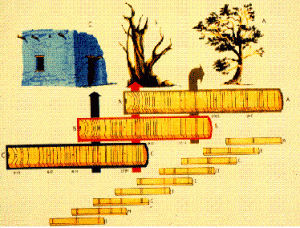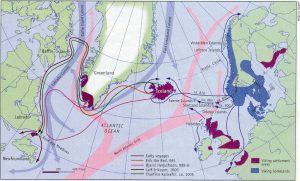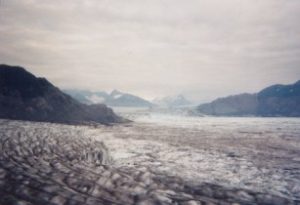Kristina Brady
The College of Wooster
Department of Geology
Disclaimer: This material is based upon work supported by the National Science Foundations Grant No. 9910805. Any opinions, finding, and conclusions or recommendations expressed in this material are those of the author and do not necessarily reflect the views of the National Science Foundation.
<– Return to main pages list
Navigation
When and what was the Medieval Optimum?
The Medieval Optimum, also known as the Medieval Warm Period (MWP), is believed to span the 8th through 12th centuries AD. It was a time of generally warmer climates, with the warmest period from 950 to 1045 AD. The question remains however, just how warm was it? By using tree-ring records as well as other paleoclimatic proxies such as pollen, ice cores, and lake sediments we are getting closer to an answer. As global warming becomes a larger concern, determining past temperatures becomes increasingly important for predicting the climate in the future.
Evidence for the Medieval Optimum
Using dendroclimatology, the study of climate using tree rings, records of the past millennia and more have been made. These tree-ring chronologies are made by cross-dating living with older wood by matching up patterns of ring widths or other distinguishing characteristics. By looking at the ring widths for particular years, it is possible to infer what the temperatures were like during that year. For more on dendrochronology click here.

Past studies using these techniques placed the MWP around 1000-1200 AD. In 1999 Mann et al. created a 1000 year reconstruction using true annual temperatures. There is evidence for a warm period, but it is not very pronounced. Recent studies, such as that of Esper et al.(2002), however show that the MWP may have taken place earlier in the record and that it is closer in temperature to that of today. In this study ring widths from only the warm season were used, as it is believed that they may better record true climate signals. The existing chronology from the 8th and 9th centuries lacks the strength of later records, so more work is necessary to place constraints on the timing and temperatures of the MWP.

Historical evidence is also available to support the MWP. During the 9th and 10th centuries Scandinavian settlers migrated across the Atlantic Ocean and started inhabiting both Iceland and Greenland. This journey was more manageable because warm currents removed large icebergs from the North Atlantic. The warm temperatures also gave the land a more inviting appearance. Upon their arrival the Vikings were able to manage some of their own crops and survive in this harsh environment (McGovern and Perdikaris, 2000). However as the Little Ice Age(LIA) took over, Greenland was no longer hospitable to the Scandinavian Settlers. For more on the Vikings during the MWP and LIA click here.

Implications of the Medieval Optimum
Understanding global warming is key to predicting what the world will look like in the future. Perhaps the MWP was a natural warming without anthropogenic influences.
One big concern involving glaciers and global warming is sea level rise. Estimates made about the extent of a rise made in the past have not taken into consideration the effect of Alaska’s glaciers. A recent study by Arendt et al.(2002) shows that Alaska may have a bigger impact on this than thought. Alaska contains the largest glaciers outside of the polar regions and catastophic retreat has been observed in recent years. Problems associated with sea level rise are coastline damages and changing estuary conditions.

My Research
I have spent my summer working in the dendrochronology lab at the College of Wooster under the direction of Greg Wiles. Along with two other students, Megan Kennedy and Suzanne Lucas, I am working to extend the existing chronology from the Prince William Sound region of Alaska back far enough to cover the MWP. Hopefully by doing so, we will be able to answer some of the questions about the duration, temperatures, and extent of the MWP. In August I traveled to the Columbia Glacier with Greg and Megan to collect more discs and cores that should date further back in time.
Links
For more information on the Medieval Warm Period try the National Oceanographic and Atmospheric Administrations web page on global warming.

References
- Briffa, K.R., Osborn, T.J., 2002, Blowing Hot and Cold, Science vol.295, p.2227-2228
- Broecker, W.S, 2002, Paleoclimate: Was the Medieval Warm Period Global?, Science vol. 291, p. 1497
- Cook, E.R., Palmer, J.G., and D’Arrigo, R.D., Evidence for a ‘Medieval Warm Period’ in a 1,100 Year Tree-Ring Reconstruction of Past Summer Temperatures in New Zealand,
- Esper, J., Cook, E.R., Schweingruber, F.H., 2002, Low-Frequency Signals in Long Tree-Ring Chronologies for reconstructing Past Temperature Variability, Science vol. 295, p. 2250-2253
- Grissino-Mayer, H.D., Last updated July 17, 2002, Henri D. Grissino-Mayer’s Science of dendrochronology Web Pages, accessed on August 5, 2002 http://web.utk.edu/~grissino/
- Mann, M.E., Bradley, R.S., and Hughes, M.K., 1999, Geophysical Research Letters vol. 26, p.759
- Meier, M.F., and Dyurgerov, M.B, 2002, How Alaska Affects the World, vol. 297, p. 350-351
- McGovern, T.H. and Perdikaris, S., 2000, The Vikings’ Silent Saga, Natural History vol.109, 9. 50-57
